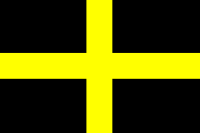








Designed by Nigel G Wilcox

Everything For The Metal Detectorist - National Flags





Powered By Sispro1
British, The Red Dragon - Welsh Flag
The Flag of Wales (Welsh: Baner Cymru or Y Ddraig Goch, meaning "The Red Dragon ") consists of a red dragon passant on a green and white field. As with many heraldic charges, the exact representation of the dragon is not standardised and many renderings exist.
The flag incorporates the Red Dragon of Cadwaladr , King of Gwynedd, along with the Tudor colours of green and white. It was used by Henry VII at the Battle of Bosworth Field in 1485 after which it was carried in state to St Paul's Cathedral. The red dragon was then included in the Tudor royal arms to signify their Welsh descent. It was officially recognised as the Welsh national flag in 1959.
Wales and Bhutan are the only countries to have a dragon as a major design element on their flag, though the Chinese flag also featured a dragon during the Qing Dynasty , and a dragon appears on the badge of the George Cross on the flag of Malta .
Red Dragon of Wales
The flag was granted official status in 1959, but the red dragon itself has been associated with Wales for centuries, though the origin of the adoption of the dragon symbol is now lost in history and myth. A possible theory is that the Romans brought the emblem to what is now Wales during their occupation of Britain in the form of the Draco standards born by the Roman cavalry, itself inspired by the symbols of the Dacians or Parthians.The green and white stripes of the flag were additions by the House of Tudor, the Welsh dynasty that held the English throne from 1485 to 1603. Green and white are also the colours of the leek, another national emblem of Wales.
The oldest known use of the dragon to represent Wales is from the Historia Brittonum, written around 830; the text describes a struggle between two serpents deep underground, which prevents King Vortigern from building a stronghold. This story was later adapted into a prophecy made by the wizard Myrddin (or Merlin) of a long fight between a red dragon and a white dragon. According to the prophecy, the white dragon, representing the Saxons , would at first dominate but eventually the red dragon, symbolising the Celts, would be victorious and recapture Lloegr. According to the legend, this victory would be brought about by Y Mab Darogan. This is believed to represent the conflict in the 5th and 6th centuries between the British Celts and the invading Saxons. A version of the tale also appears as part of the poem 'Cyfranc Lludd a Llefelys' in the Mabinogion .One twelfth century account of this is Geoffrey of Monmouth's Historia Regum Britanniae, where he states Merlin's prophecies.
The red dragon is popularly believed to have been the battle standard of Arthur and other ancient Celtic Romano-British leaders. It is particularly associated in Welsh poetry with Cadwaladr king of Gwynedd from c.655 to 682.
Despite the close link throughout early Welsh history, the dragon was not used exclusively as a symbol for Wales during this period, and it was used throughout Britain as a symbol of authority. In 1138 it was adopted by the Scottish as a royal standard, and Richard I took a dragon standard to the Third Crusade in 1191. Henry III fought under the dragon at the Battle of Lewes and it was used later by Edward III at the Battle of Cr cy. The Battle of Cr cy has a notable connection to Wales, due to Edward's use of Welsh longbowmen from Llantrisant, who wore the colours of green and white, the Tudor colours, which would later be used as the background colours of the flag of Wales.
In 1400 Owain Glyndwr raised the dragon standard during his revolts against the occupation of Wales by the English crown. Fifteen years later the English crown, under the rule of Henry V, used the red dragon standard itself during the Battle of Agincourt. The English forces during the battle utilised Welsh longbowmen, along with their own archers. In 1485, the most significant link between the symbol of the Red Dragon and Wales occurred when Henry Tudor flew the red dragon of Cadwallader during his invasion of England. Henry was of Welsh descent and after leaving France with an army of 2000, landed at Milford Haven on 7 August. He made capital of his Welsh ancestry in gathering support and gaining safe passage through Wales. Henry met and fought Richard III at the Battle of Bosworth Field, and in victory took the English throne. After the battle, Henry carried the Red Dragon standard in state to St. Paul's Cathedral, and later the Tudor livery of green and white was added to the flag.
Modern use
In 1807 the red dragon on a green mount was adopted as the Royal Badge of Wales and on 11 March 1953 the motto Y Ddraig goch ddyry cychwyn ('The red dragon gives impetus') was added, a line from the poem by Deio ab Ieuan Du which metaphorically refers to a bull copulating. The badge was the basis of a flag of Wales in which it was placed on a horizontal white and green bicolour. In 1959 government use of this flag was dropped in favour of the current flag at the urging of the Gorsedd of Bards. Today the flag can be seen flying from the Welsh Assembly building in Cardiff, and from the Wales Office in Whitehall, London each day.
The flag incorporates the Red Dragon of Cadwaladr , King of Gwynedd, along with the Tudor colours of green and white. It was used by Henry VII at the Battle of Bosworth Field in 1485 after which it was carried in state to St Paul's Cathedral. The red dragon was then included in the Tudor royal arms to signify their Welsh descent. It was officially recognised as the Welsh national flag in 1959.
Wales and Bhutan are the only countries to have a dragon as a major design element on their flag, though the Chinese flag also featured a dragon during the Qing Dynasty , and a dragon appears on the badge of the George Cross on the flag of Malta .
Red Dragon of Wales
The flag was granted official status in 1959, but the red dragon itself has been associated with Wales for centuries, though the origin of the adoption of the dragon symbol is now lost in history and myth. A possible theory is that the Romans brought the emblem to what is now Wales during their occupation of Britain in the form of the Draco standards born by the Roman cavalry, itself inspired by the symbols of the Dacians or Parthians.The green and white stripes of the flag were additions by the House of Tudor, the Welsh dynasty that held the English throne from 1485 to 1603. Green and white are also the colours of the leek, another national emblem of Wales.
The oldest known use of the dragon to represent Wales is from the Historia Brittonum, written around 830; the text describes a struggle between two serpents deep underground, which prevents King Vortigern from building a stronghold. This story was later adapted into a prophecy made by the wizard Myrddin (or Merlin) of a long fight between a red dragon and a white dragon. According to the prophecy, the white dragon, representing the Saxons , would at first dominate but eventually the red dragon, symbolising the Celts, would be victorious and recapture Lloegr. According to the legend, this victory would be brought about by Y Mab Darogan. This is believed to represent the conflict in the 5th and 6th centuries between the British Celts and the invading Saxons. A version of the tale also appears as part of the poem 'Cyfranc Lludd a Llefelys' in the Mabinogion .One twelfth century account of this is Geoffrey of Monmouth's Historia Regum Britanniae, where he states Merlin's prophecies.
The red dragon is popularly believed to have been the battle standard of Arthur and other ancient Celtic Romano-British leaders. It is particularly associated in Welsh poetry with Cadwaladr king of Gwynedd from c.655 to 682.
Despite the close link throughout early Welsh history, the dragon was not used exclusively as a symbol for Wales during this period, and it was used throughout Britain as a symbol of authority. In 1138 it was adopted by the Scottish as a royal standard, and Richard I took a dragon standard to the Third Crusade in 1191. Henry III fought under the dragon at the Battle of Lewes and it was used later by Edward III at the Battle of Cr cy. The Battle of Cr cy has a notable connection to Wales, due to Edward's use of Welsh longbowmen from Llantrisant, who wore the colours of green and white, the Tudor colours, which would later be used as the background colours of the flag of Wales.
In 1400 Owain Glyndwr raised the dragon standard during his revolts against the occupation of Wales by the English crown. Fifteen years later the English crown, under the rule of Henry V, used the red dragon standard itself during the Battle of Agincourt. The English forces during the battle utilised Welsh longbowmen, along with their own archers. In 1485, the most significant link between the symbol of the Red Dragon and Wales occurred when Henry Tudor flew the red dragon of Cadwallader during his invasion of England. Henry was of Welsh descent and after leaving France with an army of 2000, landed at Milford Haven on 7 August. He made capital of his Welsh ancestry in gathering support and gaining safe passage through Wales. Henry met and fought Richard III at the Battle of Bosworth Field, and in victory took the English throne. After the battle, Henry carried the Red Dragon standard in state to St. Paul's Cathedral, and later the Tudor livery of green and white was added to the flag.
Modern use
In 1807 the red dragon on a green mount was adopted as the Royal Badge of Wales and on 11 March 1953 the motto Y Ddraig goch ddyry cychwyn ('The red dragon gives impetus') was added, a line from the poem by Deio ab Ieuan Du which metaphorically refers to a bull copulating. The badge was the basis of a flag of Wales in which it was placed on a horizontal white and green bicolour. In 1959 government use of this flag was dropped in favour of the current flag at the urging of the Gorsedd of Bards. Today the flag can be seen flying from the Welsh Assembly building in Cardiff, and from the Wales Office in Whitehall, London each day.

Name: Y Ddraig Goch (The Red Dragon) Use Civil and state flag Proportion 3:5 Adopted 1959 Design Per fess Argent and Vert, a dragon passant Gules
Flag of Wales

Flag of St. David
Apart from the national Flag of Wales, the flag most associated with the country of Wales is the Flag of Saint David. The Flag of St David has grown in recognition from the late 20th century to the early 21st century. The Flag of St David, a yellow cross on a black field, is used in the emblem of the Diocese of St David's and is flown throughout Wales during St. David's Day , and in recent times the flag has been adopted as a symbol of Welsh nationalism .
However, traditionally, in both Protestant and Catholic traditions, crossed emblems have only been allocated to those martyred in the name of Christianity. Examples are saints such as St. Andrew (Scotland), St. George (England), St Denis (France), St. Alban (England/Hertfordshire). This argument was decisive in the rejection of a supposed St. Patrick's Cross to depict Ireland.
However, traditionally, in both Protestant and Catholic traditions, crossed emblems have only been allocated to those martyred in the name of Christianity. Examples are saints such as St. Andrew (Scotland), St. George (England), St Denis (France), St. Alban (England/Hertfordshire). This argument was decisive in the rejection of a supposed St. Patrick's Cross to depict Ireland.

Courtesy of Wikipedia
Wales
Union Flags
Flag Menu
Copyright All Rights Reserved by Nigel G Wilcox E-Mail: ngwilcox100@gmail.com
The Paragon Of Metal Detecting
& Archaeology
& Archaeology
5. Menu
Pages
Member NCMD























